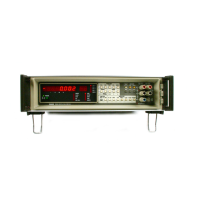8505A
erases previously recorded values.
Both Peak
mode
and
peak
values
are lost during
a
Power-Up
or Reset
condition.
2-103.
LIMITS
2-104.
The Limits mode
may be employed
to display
a
pass-fail
indication
of measurement
values.
The mode is
entered when
a single
high
or low limit
value is
stored, or
when the LIMITS button
is pushed. A
second store
sequence must
be used if both high and
low limits
are
desired.
Either the normally
displayed
value or
programmed numerics
may be used for the
limit values.
For
example, high and low limits
of 12.05
and 11.95
would be programmed
as follows:
STORE 1 2 .
0 5 HI
STORE I I .
9 5
LO
In this
example,
the multimeter enters the Limits
mode
when either the HI or LO
button is first pushed.
Mode
entry is verified
by
a display of HI,
LO, or PASS. In this
case, readings higher than
12.05
yield
a HI display,
readings lower than 1 1
.95
yield
LO,
and all
other readings
yield
PASS.
The limit
value(s) are compared
to the now
transparent display reading with all other
parameters
and
operations still
in effect.
2-105.
A
display
reading can also be stored
as a limit
value. Use the following
sequence:
STORE
HI (or LO)
2-106.
Use of Limits mode
does not interrupt other
uses
of the
multimeter.
No measurement
parameter
or
mathematic operation is changed:
The other
special
operation (Peak)
may be used simultaneously with
Limits
mode. Any of the measurement
parameters or
operations
may be enabled, changed, or recalled while
in the Limits
mode: the display responds in the normal
fashion
during
this process
and
automatically reverts
to limits
indications once the
process is complete. Limits
values
may be recalled at any time
(Limits mode enabled
or
disabled). The recall
sequence does not change the
state of
the Limits mode. The following recall
sequence is
used:
RECALL HI
LIMITS
RECALL LO LIMITS
The
recalled value is latched
in the display
as
long
as the
LIMITS button is held depressed.
2-107.
Pushing the LIMITS button
toggles the
multimeter into or out
of the Limits mode whether
or not
limits values have been entered.
A function change
disables the Limits mode, but retains
any existing limit
values. Once stored, limits values are retained
during all
but Power-Up and Reset
sequences.
2-108.
Remote Control
2-109.
The multimeter
may be equipped
with
any of
three remote interface modules.
These modules
are
fully
explained in Section
6.
When
the
-05
IEEE Interface
is
installed, the front panel
LCL/RMT
push button
can be
used
to enable local control,
but cannot
be used
to enable
remote control. Remote control
can only
be commanded
from the remote
location with this
interface.
2-110.
The LCL/RMT
push button may
be used to
toggle into/ out
of
remote
control when
either the
-06
Bit
Serial or the
-07
Parallel Interface
is installed.
Whenever
the multimeter is in remote control,
whether
commanded
locally or from
the remote, the REMOTE
annunciator
is
lighted.
2-111.
When in remote,
only the POWER
push
button
remains operational at all times.
The LCL/RMT
push
button
may
remain
operational, but is
disabled
by a local
lockout or display off
command from the remote
(refer
to
Section
6).
A power interruption
returns the
multimeter
to local control.
2-112.
Calibration
Mode
2-113.
DESCRIPTION
2-114.
The rear panel
calibration switch
is used
to
enable or
disable
the Calibration
mode
(remove
calibration seal
for access).
The AVG/(CAL)
annunciator flashes when the
Calibration
mode is
enabled, or
is lit
steadily when
the Averaging
mode
is
enabled. Regular multimeter
operation is
significantly
altered while in the Calibration
mode:
1.
Power
must not be cycled
on or off when
the
Calibration mode is activated
(rear panel
Calibration
Switch on).
2. Overrange conditions no longer
cause
a special
flashing “HHHHHH” indication.
3. Averaging mode is locked out:
the Calibration
and Averaging modes
are mutually
exclusive.
However, pushing the AVG
button when
Calibration
mode is on does
enable or disable
latching error indications.
4. All mathematic
operations
and special
operations are disabled.
5.
7-1/2
digits are displayed on
10V dc range
and
6-1/2 digits are displayed
on all other
functions
and
ranges. A sign
(±)
is displayed
for all functions
to
facilitate potentiometer
adjustment.
6. Calibration
correction factors
(for each
range
in V DC, A DC, OHMS,
and for VAC
ranges
at a
frequency of interest) and
the calibration
date may
be stored.
2-24

